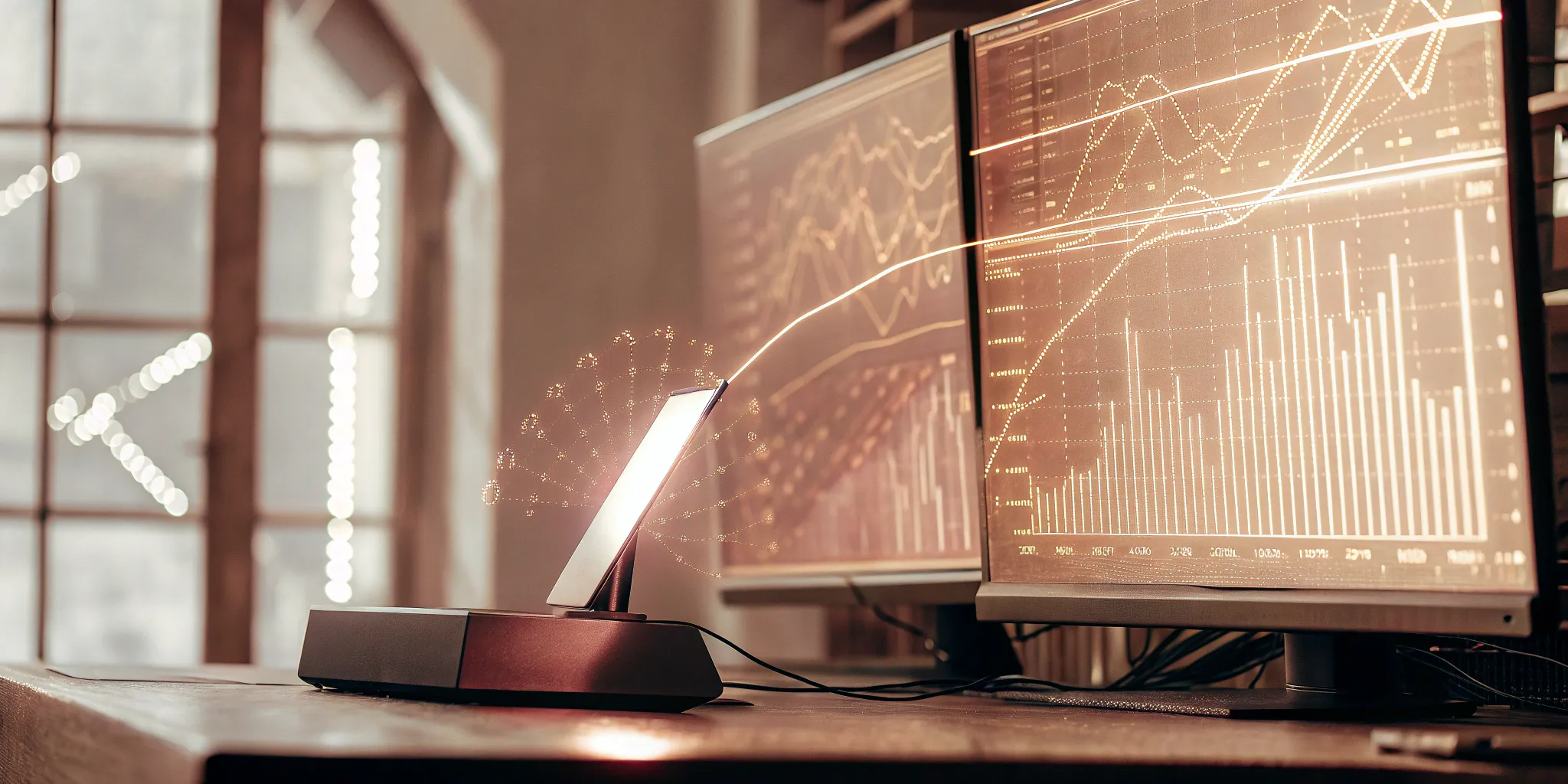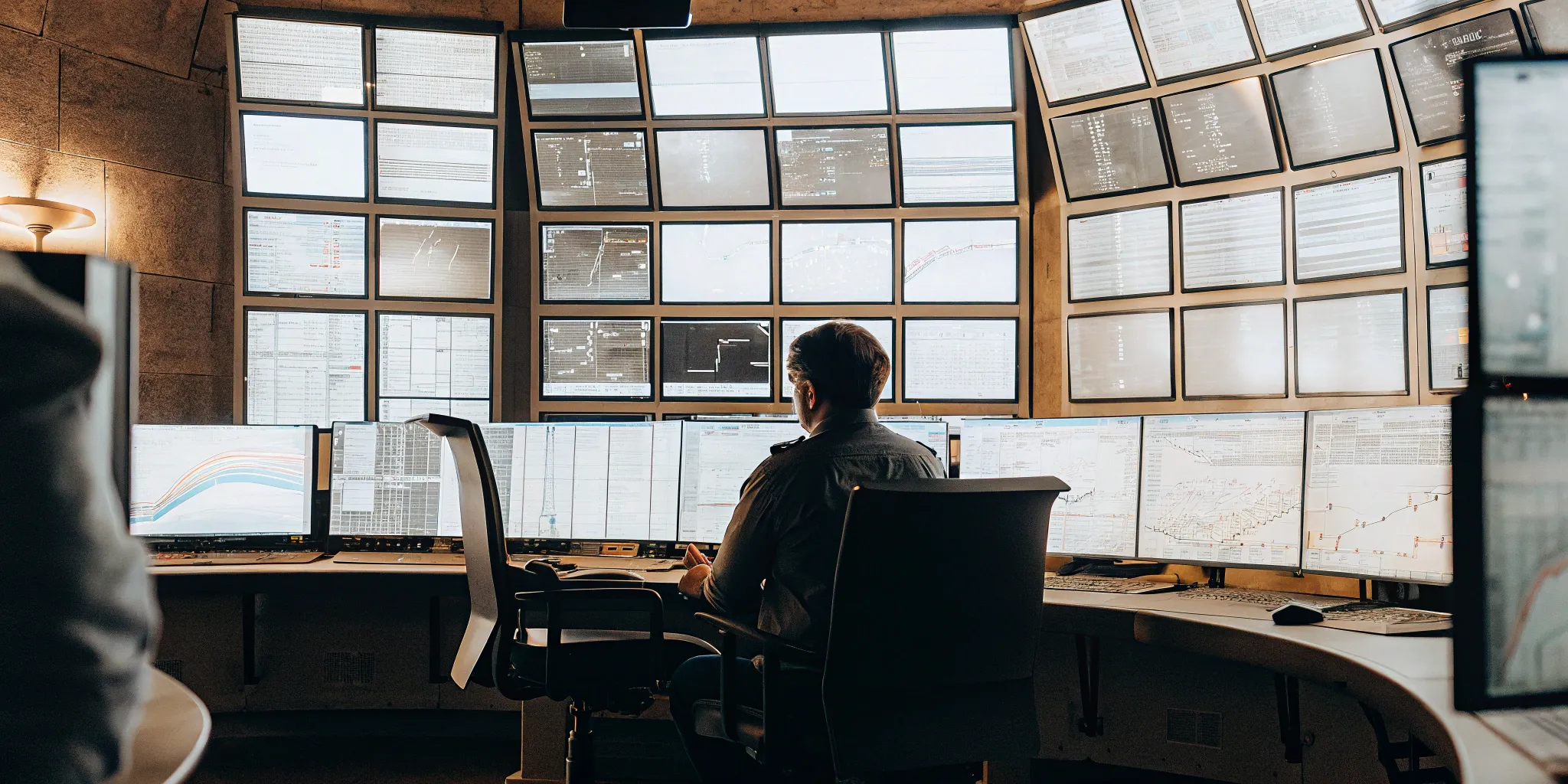Feeling overwhelmed by the complexities of trading? You’re not alone. Many investors are turning to ai tradebots to simplify their approach and potentially improve their returns. These automated systems leverage the power of artificial intelligence to analyze markets, execute trades, and manage risk, all without human intervention. But before you jump in, it’s essential to understand how these bots work, their potential benefits, and the risks involved. This guide will demystify ai tradebots, providing a clear overview of their functionalities, key features, and what to consider when choosing a platform.
Key Takeaways
- AI tradebots offer speed and efficiency by automating market analysis and trade execution, removing emotional biases from your investment strategy. Choose a bot that aligns with your trading style and risk tolerance.
- Leading platforms like FN Capital, Cryptohopper, and 3Commas provide various features such as backtesting and customizable strategies, catering to both beginners and experienced traders. Research and compare these platforms to find the best fit for your needs.
- Successfully using AI tradebots requires understanding market volatility, potential technical glitches, and the importance of human oversight. Actively monitor performance, adjust strategies as needed, and stay informed about market trends to maximize your chances of success.
What Are AI Tradebots? How Do They Work?
AI tradebots are software programs that automate buying and selling assets, using artificial intelligence to time their entries. These bots leverage machine learning, natural language processing, and other AI techniques to inform their trading decisions. Think of them as tireless digital assistants, constantly scanning markets and executing trades based on pre-defined strategies or real-time market analysis. This automation removes emotional decision-making from trading, a common pitfall for many.
Definition and Core Functionalities
At their core, AI tradebots aim to execute profitable trades autonomously. They achieve this by continuously monitoring market conditions, analyzing historical data, and identifying potential trading opportunities. These bots can execute trades much faster than a human, capitalizing on fleeting market inefficiencies. They operate based on algorithms, sets of rules that dictate their behavior in response to market changes. These algorithms can be pre-programmed with specific strategies or designed to adapt and learn from new data.
Key Components of AI Trading Systems
Effective AI trading systems rely on several key components. A robust risk management system is crucial, as is the ability to execute trades with precision and speed. Performance metrics, such as ROI and drawdown, provide insights into the bot’s effectiveness. Backtesting, a process of simulating trades on historical data, helps refine strategies before deploying them in live markets. Real-time monitoring tools allow users to track the bot’s performance and make adjustments as needed. Finally, benchmarking against other trading systems or market indices provides valuable context for evaluating results. For more information on evaluating bot performance, check out this helpful guide.
How AI Algorithms Analyze Market Data
AI algorithms analyze market data by identifying patterns and trends that might not be apparent to a human trader. They can process vast amounts of information, from price charts and technical indicators to news sentiment and social media activity. Machine learning algorithms can adapt to changing market conditions, refining their strategies over time. For example, an algorithm might identify a recurring pattern where a particular stock tends to rise after positive news announcements. The bot can then be programmed to automatically buy that stock when similar news emerges. To learn more about AI trading bots, explore this investor’s guide.
How AI Insights Execute Trades
Once an AI algorithm identifies a trading opportunity, it triggers an order execution. This process can be fully automated, with the bot placing buy or sell orders directly with an exchange. The speed of execution is critical, especially in fast-moving markets. Some bots use high-frequency trading strategies, executing thousands of trades per second to capture small price movements. Risk management tools, such as stop-loss orders, are integrated to limit potential losses. The entire process, from market analysis to trade execution, happens automatically, allowing traders to focus on other aspects of their investment strategy. For insights into essential metrics for evaluating algo trading performance, see this resource.
Top AI Tradebots
Looking for an AI-powered advantage in the markets? Several platforms offer automated trading solutions, each with its own strengths and target audience. Let’s explore some of the leading AI tradebots available.
FN Capital’s FAST AI
FN Capital’s FAST AI is engineered for consistent returns, operating 24/7 to capitalize on market opportunities. This AI trading system uses sophisticated algorithms to analyze market trends and execute trades automatically, focusing on the EUR/USD pair for optimal liquidity. A key differentiator is its publicly verified, four-year track record, offering transparency and building trust with investors. Learn more about how FN Capital blends AI and algorithmic trading in their investor’s guide.
Cryptohopper
Cryptohopper is a popular choice for automating cryptocurrency trades around the clock. Its user-friendly interface caters to both beginners and experienced traders. Whether you’re looking for pre-built strategy templates or want to explore backtesting, Cryptohopper offers a range of features to refine your approach.
3Commas
3Commas stands out with its versatility, providing automated trading bots alongside portfolio management and social trading features. This platform offers a flexible solution for those looking to enhance their crypto trading strategies. Traders of all levels can explore 3Commas to see if it fits their needs.
TradeSanta
TradeSanta simplifies automated trading with its cloud-based platform. Connecting to various cryptocurrency exchanges, TradeSanta offers smart trading features and customizable bots, putting you in control of your trading experience. Check out TradeSanta to learn more about their automated trading solutions.
Trality
For traders who prefer a hands-on approach to bot creation, Trality offers a platform to build, backtest, and deploy bots using Python. This approach allows for a high degree of customization, appealing to both beginners and experienced traders seeking to automate their trading strategies. See how Trality empowers traders with its Python-based bot creation platform.
Haasonline
Haasonline provides a comprehensive suite of tools for serious traders. Supporting multiple cryptocurrencies and exchanges, this platform offers advanced features for strategy development, backtesting, and automated trading. Explore Haasonline’s platform to see if its robust features align with your trading goals.
Key Features and Benefits of AI Tradebots
AI tradebots offer several advantages for traders of all skill levels. Let’s explore some key features and benefits that make them a powerful tool in today’s markets.
24/7 Automated Trading
Unlike human traders, AI tradebots operate continuously. This 24/7 automated trading allows for constant market engagement, capitalizing on opportunities anytime. This is particularly useful in the fast-paced world of forex and cryptocurrency markets, where opportunities can appear at any hour. FN Capital offers additional information on automated trading in their guide to AI-powered trading solutions.
Rapid Data Analysis and Decision-Making
AI tradebots excel at processing large amounts of data quickly. They can analyze market trends, news sentiment, and technical indicators much faster than a person. This rapid analysis leads to faster decision-making and trade execution, potentially increasing profitable outcomes. While AI provides speed and efficiency, remember that continuous monitoring and strategy adjustments are essential for long-term success, as explained in FN Capital’s guide to AI trading bots.
Emotion-Free Trading
Emotions often lead to impulsive trading decisions. Fear, greed, and hope can cloud judgment and disrupt even well-planned strategies. AI tradebots remove this emotional element, executing trades based solely on pre-defined rules and data analysis. This emotion-free approach promotes discipline and consistency, crucial for long-term profitability. Platforms like Cryptohopper highlight this benefit, showing how automated systems remove emotional biases from trading.
Backtesting and Strategy Optimization
Before using a live trading strategy, testing its effectiveness is crucial. AI tradebots often include backtesting features, allowing you to simulate your strategy against historical market data. This offers valuable insights into how your strategy would have performed previously, helping you identify potential weaknesses and refine it for future performance. For a deeper look at backtesting, review these key metrics for evaluating AI trading systems.
Risk Management
Managing risk is critical in trading. AI tradebots can include risk management features that automatically adjust position sizes, set stop-loss orders, and monitor overall portfolio exposure. By analyzing metrics like profitability, risk exposure, and execution accuracy, these bots can help optimize trading performance while minimizing potential losses. Discover more about evaluating bot trading performance and find helpful risk management tips.
Customization Options
Many AI tradebots offer significant customization. This allows you to tailor strategies to your specific trading style and risk tolerance. You can adjust parameters, define entry and exit rules, and even include your own technical indicators. This flexibility, along with user-friendly interfaces and backtesting capabilities, makes AI tradebots adaptable to various trading approaches. FN Capital’s guide to AI trading bots provides more information on customization options.
Choose the Right AI Tradebot
Not all AI tradebots are created equal. Finding the right one requires careful consideration of your individual needs and preferences. Here’s a breakdown of key factors to evaluate:
Assess Your Trading Goals and Experience
Before exploring AI trading, define your objectives. Are you a beginner looking for a user-friendly platform? Or are you an experienced trader seeking advanced features and customization? Understanding your goals and experience level will help you narrow the options. As machine learning metrics suggest, aligning your bot choice with your trading style is crucial for long-term success. A seasoned trader might prioritize in-depth technical analysis, while a newcomer might prefer a simpler, automated approach.
Compare Features and Functionalities
Different tradebots offer different features. Some specialize in specific asset classes (like crypto or forex), while others offer a wider range. Look for features like customizable strategies, backtesting capabilities (to test strategies against historical data), and a user-friendly interface. Remember, AI can automate your trading, but it isn’t entirely hands-off. You’ll still need to monitor performance and adjust your bot’s strategy.
Evaluate Pricing and Subscriptions
AI tradebots come with various pricing models, from one-time purchases to monthly or annual subscriptions. Some platforms may also charge commissions on trades. Carefully evaluate the pricing structure and ensure it aligns with your budget and trading volume. AnalystAnswers offers comprehensive reviews and pricing comparisons of different AI trading software.
Consider User Interface and Ease of Use
A clunky interface can make even the most powerful AI tradebot frustrating. Look for a platform that is intuitive and easy to use, even if you’re not tech-savvy. Features like clear dashboards, customizable alerts, and readily available customer support can significantly enhance your trading experience. StockChartPro offers insights into user-friendly AI stock trading tools.
Check Exchange Integration
Ensure the tradebot integrates seamlessly with the exchanges you plan to use. Compatibility issues can lead to delays and missed trading opportunities. Before committing to a platform, double-check that it supports your preferred exchanges and offers the connectivity you need. Performance reviews can offer valuable insights into integration capabilities and overall effectiveness.
Get Started with AI Tradebots
Ready to explore automated trading? Here’s how to get started with AI tradebots:
Set Up Your Trading Account
First, choose a reputable exchange or brokerage that supports automated trading and offers APIs. Make sure the platform aligns with your chosen tradebot and preferred assets (like forex or crypto). AI can automate your trading, but it’s not a set-it-and-forget-it solution. Bots offer speed and efficiency but require ongoing monitoring and strategy adjustments. Once you’ve selected a platform, complete the account setup process, which usually involves identity verification and funding your account.
Configure Your AI Trading Strategy
Now for the exciting part: configuring your AI tradebot. Look for features like customizable strategies, backtesting capabilities, and a user-friendly interface. Consider your risk tolerance and investment goals when selecting a bot. Some platforms offer pre-built strategies, while others allow you to create your own using technical indicators or other parameters. Start with smaller amounts of capital, especially when trying a new strategy. This helps you understand how the bot performs in real market conditions before committing larger sums.
Monitor and Adjust Your Bot’s Performance
After deploying your tradebot, actively monitor its performance. Metrics like ROI, drawdown, and trade latency provide valuable insights. Tools such as backtesting, real-time monitoring, and performance benchmarking enhance evaluation and highlight areas for improvement. Remember, market conditions change constantly. Regularly review and adjust your bot’s settings to maintain optimal performance and manage risk effectively.
Best Practices for AI Trading Success
For the best results with AI tradebots, combine data-driven insights with sound trading principles. Diversify your portfolio across different assets or strategies to mitigate risk. Keep learning about market trends and refine your approach over time. Metrics like Sharpe Ratio, Sortino Ratio, and win/loss ratios offer different perspectives on performance. Together, they provide a complete view of your trading system’s performance, helping you optimize strategies, protect capital, and achieve consistent profitability. Finally, remember that no trading system, automated or otherwise, guarantees profits. Manage your expectations realistically and prioritize capital preservation.
Understand Risks, Maximize Success
AI trading bots offer exciting possibilities, but it’s crucial to understand the potential downsides and how to mitigate them. Approaching automated trading with realistic expectations is key to long-term success.
Market Volatility and Unpredictability
Markets are inherently volatile and unpredictable. Random fluctuations, often called “noise,” can create the illusion of a successful pattern, leading to over-optimization and poor real-world results. A robust AI trading bot needs to be adaptable enough to handle these fluctuations without triggering unnecessary trades. Look for bots that incorporate dynamic risk management features.
Over-Reliance on Algorithms and Technical Glitches
While AI can automate your trading, it’s not a set-it-and-forget-it solution. Bots offer speed and efficiency but require ongoing monitoring and strategy adjustments. Technical glitches can also occur, potentially disrupting trades or causing unexpected losses. Regularly review your bot’s performance and have a plan for handling potential technical issues.
Regulatory Concerns and Compliance
Using AI for trading is legal, as long as it adheres to standard financial regulations and avoids fraudulent activities or market manipulation. Ensure your chosen bot operates within a compliant framework and uses regulated brokers. This protects your investments and keeps you on the right side of the law. FN Capital operates within a structured legal framework, using Third Party Fund Administrators (TPFA) to allow clients seamless access to international brokers.
Ongoing Education and Market Awareness
Staying informed about market trends and developments is essential, even with automated trading. AI bots execute trades based on pre-programmed logic, but they can’t anticipate major market shifts or black swan events. Continuous learning helps you make informed decisions about your bot’s strategy and risk tolerance. Consider simpler, less risky investment strategies if you lack significant resources and expertise.
Balance Automation with Human Oversight
AI excels at processing data and identifying patterns, but it can’t replace human judgment and intuition. Market behavior is often influenced by human emotions like fear and greed, which AI can’t fully account for. Find a balance between automation and human oversight to maximize the benefits of AI while mitigating potential risks. Regularly review your bot’s performance and be prepared to intervene when necessary. FN Capital is one of the only algorithmic trading firms offering a 100-Day Money-Back Guarantee, ensuring clients have the confidence to test FAST AI’s real-world performance.
Related Articles
- AI Trading Bots: An Investor’s Guide to Automated Trading
- AI-Powered Trading Solutions: An Investor’s Guide
- Futures Trading Algorithms: The Ultimate Guide – FN Capital
- How to Use AI to Predict Stock Market Trends – FN Capital
- How AI Improves Algo Trading: Speed, Accuracy & Profits – FN Capital
Frequently Asked Questions

Is AI trading suitable for beginners?
Absolutely! Many AI trading platforms offer user-friendly interfaces and pre-built strategies, making it accessible to newcomers. However, it’s essential to start with smaller investments and gradually increase your exposure as you gain experience. Remember, continuous learning and monitoring are key, even with automated systems.
What are the key advantages of using AI tradebots?
AI tradebots offer several benefits, including 24/7 market monitoring, rapid data analysis, and emotion-free trading. They can execute trades faster than a human, potentially capitalizing on fleeting market opportunities. Backtesting features help refine strategies, while risk management tools help protect your capital. However, remember that market volatility and technical glitches can still impact performance.
How do I choose the right AI tradebot for my needs?
Consider your trading goals, experience level, and budget. Compare features like customizable strategies, backtesting capabilities, and exchange integrations. A user-friendly interface and reliable customer support are also important factors to consider. Don’t hesitate to explore free trials or demo accounts before committing to a paid subscription.
What are the potential risks of using AI tradebots?
While AI tradebots offer many advantages, it’s important to be aware of potential risks. Market volatility and unexpected events can impact performance. Technical glitches can disrupt trades, and over-reliance on algorithms without human oversight can be detrimental. Regulatory compliance is also crucial, so choose a bot that operates within a legal framework.
How can I maximize my success with AI trading?
Combine the speed and efficiency of AI with sound trading principles. Diversify your portfolio, manage risk effectively, and stay informed about market trends. Regularly monitor your bot’s performance, adjust strategies as needed, and never stop learning. Remember that AI is a tool to enhance your trading, not a guaranteed path to riches.





